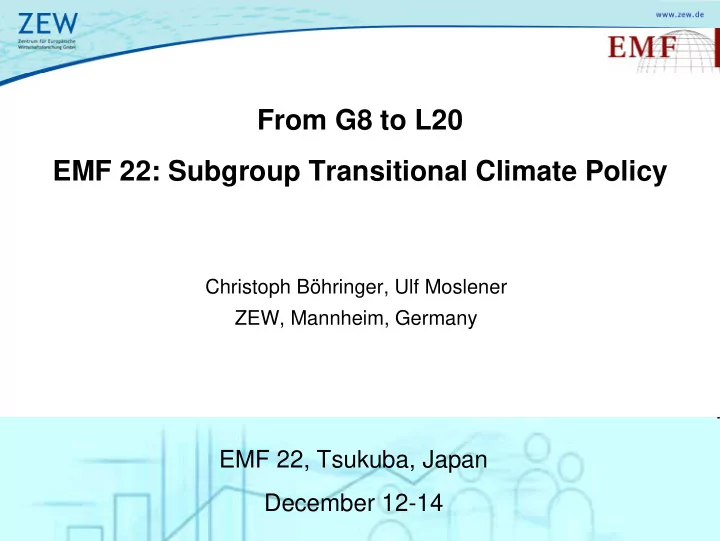

EMF 22 From G8 to L20 EMF 22: Subgroup Transitional Climate Policy Christoph Böhringer, Ulf Moslener ZEW, Mannheim, Germany EMF 22, Tsukuba, Japan December 12-14 1
EMF 22 From G8 to L20 Kyoto framework • 160-nation bureaucracy of the UN process • Too inclusive for effective negotiation process Key idea of L20 approach (e.g. Victor 2004, Kopp 2005) • Leverage on negotiation outcomes by focusing on a small number of countries (key players) – at least initially • Game-theoretic analogon: “narrow and deep versus broad and shallow” Research questions • Composition of L20: selection criteria (ex ante) • Political feasibility of L20: cost incidence of L20 leadership (ex-post) 2
EMF 22 3 L-20 Summary Statistics
EMF 22 Scenarios – Assumptions Reference scenario (“doing-nothing case”) • BaU : Business-as-Usual reference scenario Climate policy scenarios (Cap & Trade) • Global emissions cap: 30 Gt of CO2 from 2015 onwards • Comprehensive “where-flexibility” • Regional participation: • Leader (L20) • ROW (Rest of the World) N.B.: Regions which do not participate obtain BaU emissions! 4
EMF 22 Scenarios – Dimensions of Analysis Allocation rule ega Egalitarian Entitlement based on population atp Ability to pay Reduction based on GDP* ppa Reduction based on emissions Polluter pays N.B.: ATP is equivalent to sovereignty (SOV) rule. Timing of Participation ROW Leader > 2015 Global > 2015 L20trans > 2015 > 2035 L20eternal > 2015 never 5
EMF 22 Analytical Framework Key features: • Multi-sector, multi-region computable general equilibrium (CGE) model: • Intertemporal framework (time horizon: 2030): Ramsey-type growth model Base year calibration: GTAP6 • Input-output tables and bilateral trade flows for 87 regions and 57 sectors • Harmonized energy flows (IEA energy balances and statistics) Baseline projections: IEO/DOE • Region-specific projections for GDP, energy use and crude oil production • Sensitivity analysis: alternative baselines (low – ref – high) 6
EMF 22 Emissions – BaU and Ceiling 65 60 Emissions (in Gt of CO2) 55 50 45 40 35 30 2010 2015 2020 2025 2030 2035 2040 2045 2050 Time 7 BaU CO2 Ceiling
EMF 22 Emission Reduction versus BaU 70 Emission reduction requirement (% from BaU) Leaders (in case of L20) 60 50 40 Target (global aggregate) 30 20 10 ROW (in case of L20) 0 2010 2015 2020 2025 2030 2035 2040 2045 2050 Time 8
EMF 22 Carbon Value (Marginal Abatement Cost) 120 CO2 value (in US$ per ton of CO2) 100 80 60 40 20 0 2015 2020 2025 2030 2035 2040 2045 2050 Time 9
EMF 22 Implications of L20 versus Global Additional reduction requirement for Leader (in % pts) 20 15 10 5 0 -5 -10 -15 2015 2020 2025 2030 2035 2040 2045 2050 Time 10 atp ega ppa
EMF 22 Aggregate Welfare – L20eternal versus Global Welfare Implications (% HEV from BaU ) 1,5 1 0,5 Leaders 0 ROW -0,5 -1 -1,5 L20eternal Global_ega Global_atp Global_ppa 11
EMF 22 L20 as Transitional Approach Welfare Implications (% HEV from BaU ) 1,5 ega atp ppa 1 0,5 Leaders 0 ROW -0,5 -1 -1,5 L20trans L20trans L20trans Global Global Global L20eternal L20eternal L20eternal 12
EMF 22 From G8 to L20 Conclusions � Scenarios: Income transfers via carbon endowments (overall efficiency is warranted through comprehensive “where-flexibility”) � Egalitarian allocation rule: Leaders (“L20” countries) prefer leadership to global coverage due to population dynamics � Ability-to-pay and polluter-pays (sovereignty): global application of allocation rule makes “Leaders” group better off than leadership � Leadership is much less costly (to the Leaders) if restricted to transitional phase Caveats � Economic impacts within L20 can be quite different (and not resolved in this analysis…) � Comprehensive sensitivity analysis with respect to - key elasticities - global target trajectories for emissions - BaU projections 13 - Limited “where-flexibility” (leakage)
EMF 22 14 Backup
EMF 22 Aggregate Welfare Implications (% HEV from BaU ) L20eternal: Scenario L20 ROW Total -0.47 0.13 -0.38 L20_ega -0.63 1.21 -0.37 Global_ega L20_atp -0.47 0.13 -0.38 -0.31 -0.85 -0.39 Global_atp -0.47 0.13 -0.38 L20_ppa Global_ppa -0.28 -1.05 -0.39 L20_sov -0.47 0.13 -0.38 Global_sov -0.28 -1.05 -0.39 15
EMF 22 Aggregate Welfare Implications (% HEV from BaU ) L20trans: Scenario Leaders ROW world L20_ega -0.56 0.72 -0.38 Global_ega -0.63 1.21 -0.37 L20_atp -0.33 -0.71 -0.39 Global_atp -0.31 -0.85 -0.39 L20_ppa -0.31 -0.87 -0.39 Global_ppa -0.28 -1.05 -0.39 L20_sov -0.31 -0.87 -0.39 Global_sov -0.28 -1.05 -0.39 � Costs for Leaders substantially reduced! 16
EMF 22 Baseline-Sensitivity - Welfare (% HEV from BaU ) 1 ,5 1 0,5 Leaders ROW Leaders Hi 0 ROW Hi Leaders Lo ROW Lo -0,5 -1 -1 ,5 L20 L20 Global L20 L20 Global L20 L20 Global Eternal Trans Eternal Trans Eternal Trans 17
EMF 22 Baseline-Sensitivity - Welfare (% HEV from BaU ) 2 1,5 Leaders 1 ROW 0,5 0 -0,5 -1 -1,5 -2 L20 Eternal L20 Eternal L20 Eternal L20 Trans Global L20 Trans Global L20 Trans Global 18
Recommend
More recommend